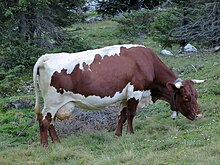Pinzgauer (beef)
| Race key |
|---|
| old type: PIN 13 meat use: PIF 74 |
Pinzgauer refers to a breed of domestic cattle .
history
The name of the cattle breed derives from the Pinzgau , today's Zell am See district in the state of Salzburg . According to morphological and genetic studies, the Pinzgauer are more closely related to the lower races than to the races of the western Alps. However, the crossing of Simmental horses is historically documented. Even before the Pinzgauer were described as a breed for the first time in 1846, “Pinzgauer Fasel” or “Pinzgauer Schlag” was used as a designation of origin. Other cattle of this type at the time, which were probably absorbed in the breed, were Lungauer, Pongauer, Mölltaler, Salzburger Schecken, Brixentaler, Tyrolean back checks, Traunsteiner and Berchtesgadener cats . In earlier times, the Pinzgauer was a classic three-purpose cattle, so it was kept in addition to milk and meat also and above all because of its pulling power. In the 19th century, breeding was mainly aimed at strong draft animals, which were needed everywhere in agriculture, including breweries and in the large sugar beet growing areas. These oxen were also known under the name of "over-dearer" . In its heyday, the Pinzgauer was the most widespread cattle in the entire territory of the Austro-Hungarian monarchy and spread even further to Eastern Europe. In 1896 the Bavarian Pinzgauer Zuchtverband was founded. In December 1900 he recorded 101,880 animals in Bavaria. The big slump in the stock figures occurred in the course of industrialization after the Second World War. The demand for draft animals declined and the Pinzgauer were displaced by animals with a higher milk yield, some Simmental cattle . As early as 1930 there were only 85,000 Pinzgau residents in Bavaria.
There is a genetically polled loft of the Pinzgauer, the Jochberger Hummeln . They go back to an almost completely white calf that was born in Tyrol in 1834 . At that time, hornless animals were still considered crippled and unusable because it was not possible to attach a forehead yoke to them. Nowadays they are no longer tense and the loose housing is increasing, for which the hornless animals are better suited (lower risk of injury). Of the "Horn lots" there are fewer than 50 copies, which applies to the Red List of endangered breeds of domestic animals in Austria as alarming inventory number. However, two bulls have been at the insemination station near Salzburg since 1988 . As a result, if there is a corresponding demand among Pinzgauer breeders, the picture could quickly change, since genetic polled status is a dominant hereditary trait.
Appearance
The animals are red-brown, a rich chestnut color is the breeding goal. Occasionally there are black animals, which, however, after an earlier appreciation as lucky charms, were no longer welcomed in breeding after the turn of the century. Black bulls were excluded from breeding and so the black color has almost disappeared today. Common to all animals is the breed-typical white markings: they have a wide white stripe from the withers over the back and rear of the thighs; Belly, underbust, udder and tail are white (back check). In addition, they have white stripes over their lower legs and upper arm, the so-called "fatschen". Adult cows today weigh approx. 600 to 700 kg with an average height at the withers of 137 cm, bulls are approx. 10 cm taller with approx. 1,000 to 1,100 kg.
Stock and performance
According to the Red List of the Society for the Preservation of Old and Endangered Pet Breeds (GEH) in Germany, the Pinzgau cattle breed is endangered, i.e. the population size has fallen below a minimum number and continues to decrease by more than 10 percent annually.
Statistics from 2001 show a population of around 360 Pinzgauers for Germany, and around 1.3 million worldwide. In 1995 there were 53,874 animals in Austria, 9883 of which were herd book cows.
Two conflicting tendencies have resulted in purebred, high-performing animals being few. Pinzgauer are mainly bred as beef cattle in suckler cow husbandry and so there is no selection for milk yield. Crossbreeds with local or distinct meat breeds are also carried out. In Austria itself, Red Holstein has been crossed since 1969 in order to increase milk yield. The goal is 6000 kg milk with 4 percent fat and 3.5 percent protein (average milk yield in Austria: 5356 kg milk with 3.89 percent fat and 3.28 percent protein, year 2005).
Although Pinzgauer lag behind other breeds in the criteria of daily weight gain and classification in trade classes, a special group of customers appreciate the pronounced marbling of the meat. The prices for calves and fattening animals are still below those of other breeds. The breeding goal in terms of meat performance is daily weight gain of 1300 g with around 58 percent slaughter.
Cultural meaning
In 2020, a special exhibition will be dedicated to Pinzgauer cattle in the mining and Gothic museum in Leogang under the title: "The Pinzgauer cattle - a cultural asset of Salzburg". This is intended to honor the centuries-long importance of the Pinzgau cattle for the local peasantry and also to elaborate on its remarkable successes in other continents.
literature
- Antje Elfrich, Elisabeth Roesicke: Cattle breeds (= AID. 1548). aid information service consumer protection, nutrition, agriculture eV, Bonn 2009, ISBN 978-3-8308-0819-0 .
- Hans Hinrich Sambraus: Endangered farm animal breeds. Their breeding history, use and preservation. Ulmer, Stuttgart 1994, ISBN 3-8001-4099-3 .
Web links
- www.geh.de
- www.bauernhof.net
- International Pinzgau Organization
- ARGE Pinzgauer Cattle Breeding Associations
- Breed description on "Fleischrinder Austria"
- Pinzgau beef . Entry no. 29 in the register of traditional foods of the Austrian Federal Ministry for Agriculture, Regions and Tourism .
- Pinzgauer beef in the Salzburg Wiki
Individual evidence
- ↑ ?: The Pinzgau beef is culture. Salzburger Nachrichten, November 4, 2019, accessed on December 21, 2019 .

